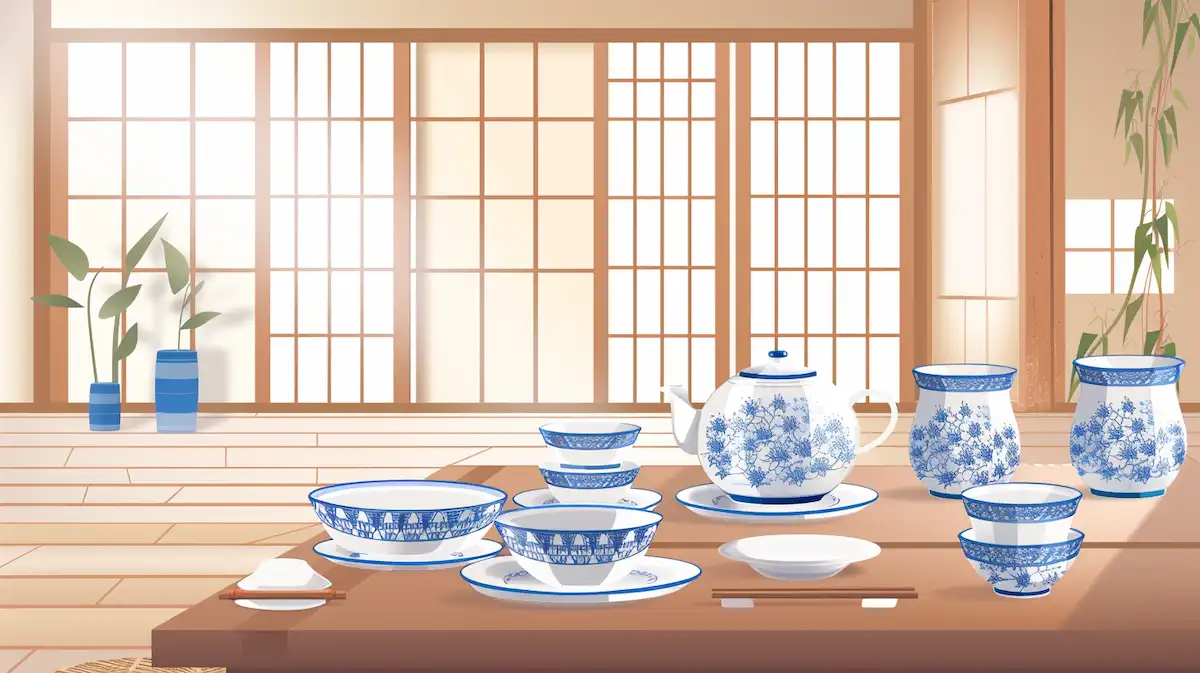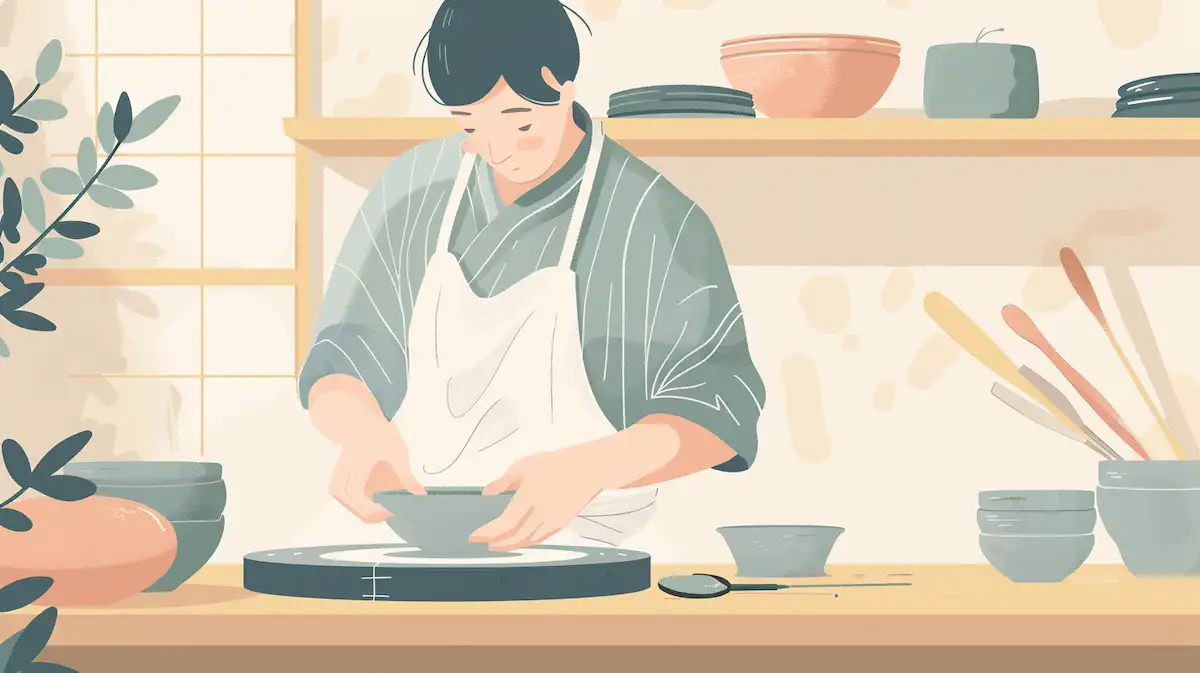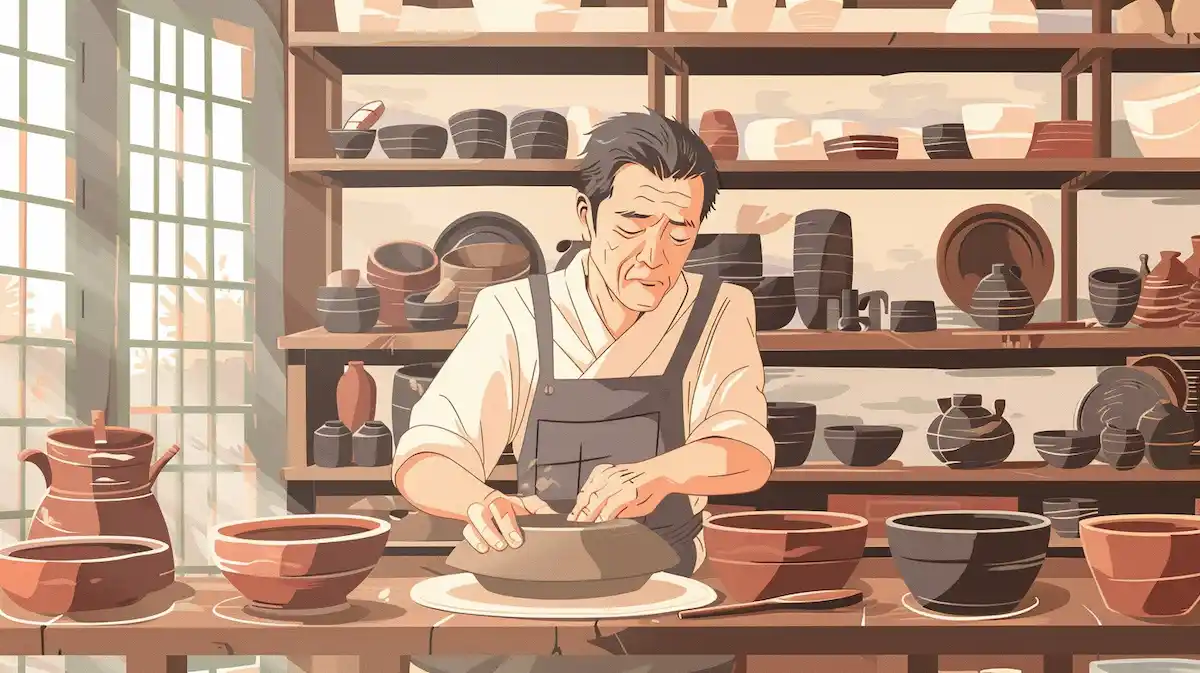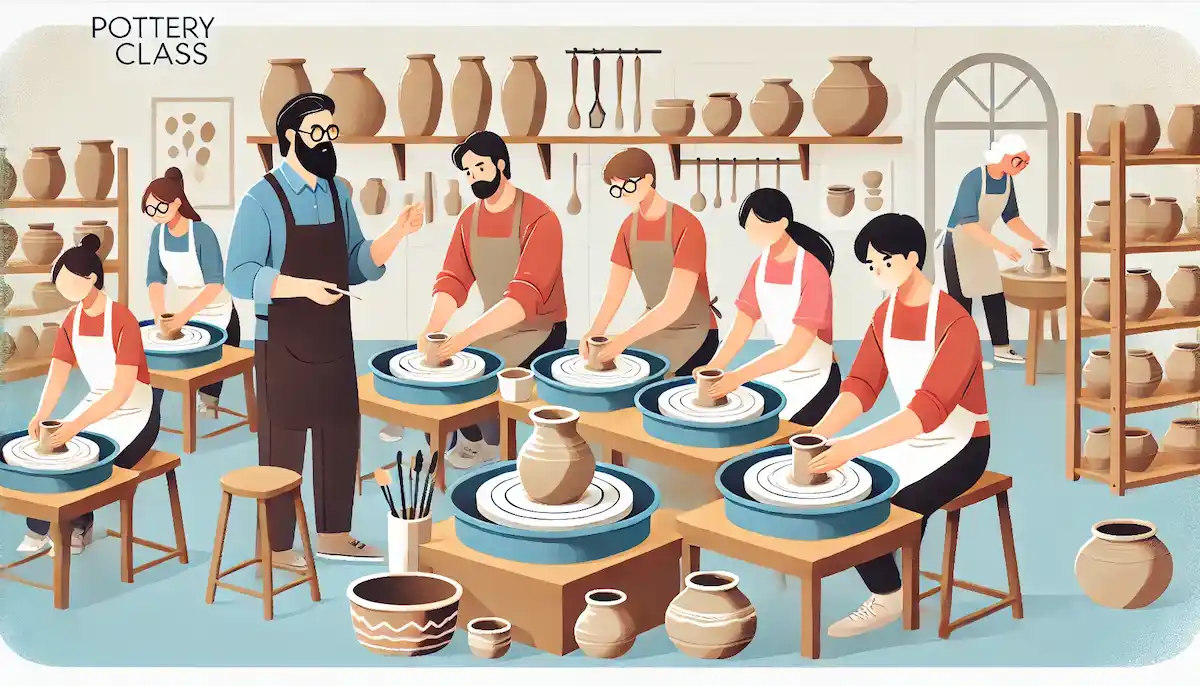陶芸を英語で説明・紹介するための基本情報と、英会話に役立つ表現をシンプルでわかりやすい英語で紹介します。
英会話ダイアローグ・関連情報・10の質問を通して、陶芸に関する英語表現を学びます。
英語
英会話ダイアローグを読む前に知っておくと良い前提知識と情報は以下の通りです。
- 陶芸の歴史:
- 陶芸は古代から存在し、日本では縄文時代からの歴史がある
- 地域ごとに独自のスタイルと技法が発展
- 陶芸の技法:
- 手びねり: 手で直接粘土を成形する技法
- ろくろ成形: 回転するろくろを使って粘土を形作る技法
- 型押し: 型を使って粘土を成形する技法
- 焼成プロセス:
- 素焼き: 低温で一度焼いて粘土を硬化させるプロセス
- 釉焼き: 素焼き後に釉薬を塗り、高温で再度焼成するプロセス
- 有名な焼き物:
- 陶芸の人気の理由:
- 創造的表現: 自分の創造力を発揮できる
- リラクゼーション: 粘土を扱うことでリラックスできる
- 実用的なアート: 日常生活で使える美しい作品が作れる
- 陶芸体験:
- 京都や東京では、初心者向けの陶芸教室や伝統的な陶芸体験が多数ある
- 旅行者にも人気で、オリジナルの作品を作ることができる
2人が陶芸について話しています。
陶芸の歴史、代表的な陶器の種類、陶芸の基本技法、焼成プロセス、有名な陶芸の町、陶芸の人気の理由や、初心者向けの陶芸体験などを話題にしています。
会話 / dialogue

Hey Key, I’ve been really interested in pottery lately. Do you know much about it?

Yeah, pottery is fascinating! It has a long history and is a significant part of many cultures, especially in Japan.

I heard that. I know Japan has a rich tradition of pottery called “yakimono.” Can you tell me more about it?

Sure! Japanese pottery has various styles from different regions. For example, Bizen pottery is known for its earthy, unglazed look, while Arita is famous for its detailed porcelain with painted designs.

That sounds interesting. What are the main techniques used in pottery?

There are a few main techniques. Hand-building involves shaping the clay with your hands, wheel-throwing uses a rotating wheel to form the clay, and molding uses a mold to shape the clay.

I’ve seen videos of people using the wheel. It looks so relaxing.

It is! Working with clay can be very calming and therapeutic. Many people find it a great way to express their creativity.

What about the firing process? How does that work?

After you shape your piece, it needs to dry. Then it goes through bisque firing, which hardens the clay at a low temperature. After that, you can apply glaze, and then it undergoes a glaze firing at a high temperature to finish it.

I see. Are there any famous pottery towns in Japan?

Yes, places like Arita in Saga Prefecture are well-known. Arita is famous for its porcelain and has many workshops and museums.

That sounds like a great place to visit. Why do you think pottery is so popular?

Pottery is popular because it combines art and practicality. You can use the items you make in your daily life. Plus, it’s a great way to relax and appreciate different cultural styles.

I’m really interested in trying a pottery class. Do you know any good places for beginners?

Definitely! Kyoto offers traditional Raku pottery experiences, and Tokyo has many beginner-friendly classes focusing on wheel-throwing or hand-building. You can even try just molding clay if you don’t want to take home a finished piece.

That sounds perfect. I’d love to make something with my own hands. Thanks for the info, Key!

No problem, Mack. Enjoy your pottery journey!
関連情報 / related information
「陶芸」について、理解を深めるための「英語での関連情報」です。
陶芸

History of Pottery
Pottery is an ancient craft that has been around for thousands of years. In Japan, pottery started in the Jomon period, which dates back over 10,000 years. Each region in Japan developed its own unique styles and techniques. This long history makes pottery a significant part of Japanese culture.
Pottery Techniques
There are several main techniques used in pottery. Hand-building involves shaping the clay with your hands. Wheel-throwing uses a rotating wheel to form the clay into shapes. Molding is another technique where a mold is used to shape the clay. These methods allow artists to create a wide variety of pottery items.
Firing Process
After shaping the clay, the pottery needs to be fired in a kiln. The first step is bisque firing, which hardens the clay at a low temperature. After this, glaze is applied to the pottery. The final step is glaze firing, where the pottery is fired at a high temperature. This process finishes the piece and gives it a glassy surface.
Famous Pottery Styles
Japan has many famous types of pottery. Bizen pottery from Okayama is known for its unglazed, earthy look. Shigaraki pottery from Shiga is famous for its tanuki (raccoon dog) statues. Arita pottery from Saga is known for its detailed porcelain with painted designs. Each style has its own unique characteristics.
Why Pottery is Popular
Pottery is popular for several reasons. It allows people to express their creativity and make unique items. Working with clay can be very relaxing and therapeutic. Pottery is also practical because you can use the items you make in your daily life. Many people enjoy learning about the different styles and techniques from various regions.
Pottery Experiences
Many places in Japan offer pottery classes and workshops, especially in cities like Kyoto and Tokyo. These classes are great for beginners and tourists. You can try traditional techniques and create your own pottery pieces. It’s a fun way to learn about Japanese culture and take home a unique souvenir.
10の質問 / 10 questions
「陶芸」について、理解を深めるための「英語での10の質問」です。
1: What is pottery?
Pottery is the art of making items like bowls, vases, and plates from clay. The clay is shaped, dried, and then fired in a kiln to create durable items.
2: How long has pottery been around?
Pottery has been around for thousands of years. In Japan, it dates back to the Jomon period, which is over 10,000 years ago.
3: What are the main techniques used in pottery?
The main techniques include hand-building, wheel-throwing, and molding. Hand-building involves shaping clay with your hands, wheel-throwing uses a rotating wheel, and molding shapes clay using a mold.
4: What is bisque firing?
Bisque firing is the first firing process in pottery. It hardens the clay at a low temperature, preparing it for glazing and the final firing.
5: What is glaze?
Glaze is a liquid coating applied to pottery. When fired, it creates a glassy surface on the pottery, adding color and making it waterproof.
6: What is the purpose of a kiln?
A kiln is an oven or furnace used to fire pottery. It reaches high temperatures to harden the clay and glaze, making the pottery durable.
7: What is the difference between Bizen and Arita pottery?
Bizen pottery is unglazed and has a natural, earthy look, while Arita pottery is known for its detailed porcelain with painted designs.
8: Why is pottery popular today?
Pottery is popular because it allows people to express creativity, relax, and create practical items. It also has a rich cultural history that many people find fascinating.
9: Where can you experience pottery in Japan?
You can experience pottery in many places in Japan, such as Kyoto and Tokyo. These cities offer pottery classes and workshops for beginners and tourists.
10: What are some common uses of pottery?
Common uses of pottery include making dishes, vases, and decorative items. Pottery can be both functional and artistic, used in daily life and as display pieces.
和訳付
会話 / dialogue

Hey Key, I’ve been really interested in pottery lately. Do you know much about it?
ねえ、キー。最近陶芸にすごく興味があるんだ。何か知ってる?

Yeah, pottery is fascinating! It has a long history and is a significant part of many cultures, especially in Japan.
うん、陶芸は魅力的だよね!長い歴史があって、多くの文化で重要な役割を果たしているんだ。特に日本ではね。

I heard that. I know Japan has a rich tradition of pottery called “yakimono.” Can you tell me more about it?
そうなんだ。日本には「焼き物」っていう豊かな陶芸の伝統があるって聞いたよ。もう少し教えてくれる?

Sure! Japanese pottery has various styles from different regions. For example, Bizen pottery is known for its earthy, unglazed look, while Arita is famous for its detailed porcelain with painted designs.
もちろん!日本の陶芸には地域ごとにさまざまなスタイルがあるんだ。例えば、備前焼は素朴な無釉の見た目で知られていて、有田焼は細かい絵付けが施された磁器で有名だよ。

That sounds interesting. What are the main techniques used in pottery?
それは興味深いね。陶芸にはどんな主要な技法があるの?

There are a few main techniques. Hand-building involves shaping the clay with your hands, wheel-throwing uses a rotating wheel to form the clay, and molding uses a mold to shape the clay.
いくつか主要な技法があるよ。手びねりは手で粘土を成形する方法で、ろくろ成形は回転するろくろを使って粘土を形作るんだ。型押しは型を使って粘土を成形する方法だね。

I’ve seen videos of people using the wheel. It looks so relaxing.
ろくろを使っている人の動画を見たことがあるよ。すごくリラックスできそうだね。

It is! Working with clay can be very calming and therapeutic. Many people find it a great way to express their creativity.
そうだよ!粘土を扱うのはとても落ち着いていて、治療的なんだ。多くの人が創造性を発揮する素晴らしい方法だと感じているよ。

What about the firing process? How does that work?
焼成プロセスはどうなの?どうやって行うの?

After you shape your piece, it needs to dry. Then it goes through bisque firing, which hardens the clay at a low temperature. After that, you can apply glaze, and then it undergoes a glaze firing at a high temperature to finish it.
成形した後は乾燥させる必要があるんだ。それから低温で素焼きして粘土を硬化させる。その後、釉薬を塗って高温で釉焼きして仕上げるんだ。

I see. Are there any famous pottery towns in Japan?
なるほど。日本には有名な陶芸の町があるの?

Yes, places like Arita in Saga Prefecture are well-known. Arita is famous for its porcelain and has many workshops and museums.
うん、佐賀県の有田町とかが有名だね。有田は磁器で有名で、多くの陶芸工房や博物館があるんだ。

That sounds like a great place to visit. Why do you think pottery is so popular?
それは訪れるのに素晴らしい場所だね。どうして陶芸がそんなに人気だと思う?

Pottery is popular because it combines art and practicality. You can use the items you make in your daily life. Plus, it’s a great way to relax and appreciate different cultural styles.
陶芸が人気なのは、芸術と実用性を兼ね備えているからだよ。自分で作ったものを日常生活で使えるし、リラックスしてさまざまな文化的なスタイルを楽しむ素晴らしい方法でもあるからね。

I’m really interested in trying a pottery class. Do you know any good places for beginners?
陶芸教室を試してみたいんだ。初心者向けの良い場所を知ってる?

Definitely! Kyoto offers traditional Raku pottery experiences, and Tokyo has many beginner-friendly classes focusing on wheel-throwing or hand-building. You can even try just molding clay if you don’t want to take home a finished piece.
もちろん!京都では伝統的な楽焼の体験ができるし、東京には初心者向けのろくろ成形や手びねりのクラスがたくさんあるよ。完成品を持ち帰りたくないなら、粘土の成形だけを楽しむこともできるよ。

That sounds perfect. I’d love to make something with my own hands. Thanks for the info, Key!
それは完璧だね。自分の手で何かを作ってみたいよ。情報ありがとう、キー!

No problem, Mack. Enjoy your pottery journey!
どういたしまして、マック。陶芸の旅を楽しんでね!
関連情報 / related information
陶芸

History of Pottery
Pottery is an ancient craft that has been around for thousands of years. In Japan, pottery started in the Jomon period, which dates back over 10,000 years. Each region in Japan developed its own unique styles and techniques. This long history makes pottery a significant part of Japanese culture.
陶芸は数千年にわたり存在してきた古代の工芸です。日本では、縄文時代から陶芸が始まり、1万年以上前にさかのぼります。日本の各地域は独自のスタイルと技法を発展させました。この長い歴史が、陶芸を日本文化の重要な部分としています。
Pottery Techniques
There are several main techniques used in pottery. Hand-building involves shaping the clay with your hands. Wheel-throwing uses a rotating wheel to form the clay into shapes. Molding is another technique where a mold is used to shape the clay. These methods allow artists to create a wide variety of pottery items.
陶芸にはいくつかの主要な技法があります。手びねりは手で粘土を成形する方法です。ろくろ成形は回転するろくろを使って粘土を形作ります。型押しは型を使って粘土を成形する技法です。これらの方法により、アーティストはさまざまな陶芸品を作成することができます。
Firing Process
After shaping the clay, the pottery needs to be fired in a kiln. The first step is bisque firing, which hardens the clay at a low temperature. After this, glaze is applied to the pottery. The final step is glaze firing, where the pottery is fired at a high temperature. This process finishes the piece and gives it a glassy surface.
粘土を成形した後、陶芸品は窯で焼成される必要があります。最初のステップは素焼きで、低温で粘土を硬化させます。その後、陶芸品に釉薬を塗ります。最後のステップは釉焼きで、高温で焼成して作品を仕上げ、ガラスのような表面を作ります。
Famous Pottery Styles
Japan has many famous types of pottery. Bizen pottery from Okayama is known for its unglazed, earthy look. Shigaraki pottery from Shiga is famous for its tanuki (raccoon dog) statues. Arita pottery from Saga is known for its detailed porcelain with painted designs. Each style has its own unique characteristics.
日本には多くの有名な陶芸スタイルがあります。岡山県の備前焼は無釉の素朴な見た目で知られています。滋賀県の信楽焼はたぬきの置物で有名です。佐賀県の有田焼は、細かい絵付けが施された磁器で知られています。それぞれのスタイルには独自の特徴があります。
Why Pottery is Popular
Pottery is popular for several reasons. It allows people to express their creativity and make unique items. Working with clay can be very relaxing and therapeutic. Pottery is also practical because you can use the items you make in your daily life. Many people enjoy learning about the different styles and techniques from various regions.
陶芸が人気の理由はいくつかあります。人々が自分の創造性を表現し、ユニークなアイテムを作ることができます。粘土を扱うことは非常にリラックスでき、治療的です。また、陶芸は実用的で、日常生活で作ったアイテムを使用することができます。多くの人が、さまざまな地域の異なるスタイルや技法を学ぶことを楽しんでいます。
Pottery Experiences
Many places in Japan offer pottery classes and workshops, especially in cities like Kyoto and Tokyo. These classes are great for beginners and tourists. You can try traditional techniques and create your own pottery pieces. It’s a fun way to learn about Japanese culture and take home a unique souvenir.
日本の多くの場所で陶芸教室やワークショップが開催されており、特に京都や東京のような都市で人気です。これらのクラスは初心者や観光客に最適です。伝統的な技法を試して、自分の陶芸作品を作ることができます。日本文化を学び、ユニークなお土産を持ち帰る楽しい方法です。
10の質問 / 10 questions
1: What is pottery?
陶芸とは何ですか?
Pottery is the art of making items like bowls, vases, and plates from clay. The clay is shaped, dried, and then fired in a kiln to create durable items.
陶芸は、粘土からボウルや花瓶、皿などのアイテムを作る技術です。粘土を成形し、乾燥させた後、窯で焼いて耐久性のある作品を作ります。
2: How long has pottery been around?
陶芸はどのくらいの歴史がありますか?
Pottery has been around for thousands of years. In Japan, it dates back to the Jomon period, which is over 10,000 years ago.
陶芸は数千年の歴史があります。日本では、1万年以上前の縄文時代にまでさかのぼります。
3: What are the main techniques used in pottery?
陶芸で使われる主な技法は何ですか?
The main techniques include hand-building, wheel-throwing, and molding. Hand-building involves shaping clay with your hands, wheel-throwing uses a rotating wheel, and molding shapes clay using a mold.
主な技法には、手びねり、ろくろ成形、型押しがあります。手びねりは手で粘土を成形し、ろくろ成形は回転するろくろを使い、型押しは型を使って粘土を形作ります。
4: What is bisque firing?
素焼きとは何ですか?
Bisque firing is the first firing process in pottery. It hardens the clay at a low temperature, preparing it for glazing and the final firing.
素焼きは陶芸における最初の焼成プロセスです。低温で粘土を硬化させ、釉薬を塗る準備や最終焼成のための準備をします。
5: What is glaze?
釉薬とは何ですか?
Glaze is a liquid coating applied to pottery. When fired, it creates a glassy surface on the pottery, adding color and making it waterproof.
釉薬は陶器に塗られる液体のコーティングです。焼成すると、陶器の表面にガラスのような層ができ、色を加えたり防水性を持たせたりします。
6: What is the purpose of a kiln?
窯の目的は何ですか?
A kiln is an oven or furnace used to fire pottery. It reaches high temperatures to harden the clay and glaze, making the pottery durable.
窯は陶器を焼くための炉やオーブンです。高温に達して粘土や釉薬を硬化させ、陶器を耐久性のあるものにします。
7: What is the difference between Bizen and Arita pottery?
備前焼と有田焼の違いは何ですか?
Bizen pottery is unglazed and has a natural, earthy look, while Arita pottery is known for its detailed porcelain with painted designs.
備前焼は無釉で自然で素朴な見た目を持ち、有田焼は細かい絵付けが施された磁器で知られています。
8: Why is pottery popular today?
なぜ今日、陶芸が人気なのでしょうか?
Pottery is popular because it allows people to express creativity, relax, and create practical items. It also has a rich cultural history that many people find fascinating.
陶芸は、創造性を表現し、リラックスし、実用的なアイテムを作ることができるため、人気があります。また、豊かな文化的歴史があり、多くの人々がそれを魅力的だと感じています。
9: Where can you experience pottery in Japan?
日本ではどこで陶芸を体験できますか?
You can experience pottery in many places in Japan, such as Kyoto and Tokyo. These cities offer pottery classes and workshops for beginners and tourists.
京都や東京など、日本の多くの場所で陶芸を体験することができます。これらの都市では、初心者や観光客向けの陶芸教室やワークショップが開催されています。
10: What are some common uses of pottery?
陶芸の一般的な用途は何ですか?
Common uses of pottery include making dishes, vases, and decorative items. Pottery can be both functional and artistic, used in daily life and as display pieces.
陶芸の一般的な用途には、食器や花瓶、装飾品の作成が含まれます。陶器は実用的でありながら芸術的でもあり、日常生活や展示品として使用されます。
words & phrases
英会話ダイアローグと関連情報に出てきた単語・フレーズです(例文は各3つ)。

unglazed : 形容詞
意味: 釉薬をかけていない。Not covered with a glaze.
(備前焼は無釉の素朴な見た目で知られている)
例文
- The pottery piece was unglazed and had a natural, earthy feel.
「その陶器は無釉で、自然で素朴な感触があった。」 - Unglazed tiles are often used in rustic designs.
「無釉のタイルは、素朴なデザインによく使われる。」 - The unglazed surface made the pottery look more traditional.
「無釉の表面が、その陶器をより伝統的に見せていた。」
porcelain : 名詞
意味: 磁器。A white, translucent ceramic material made by firing a pure clay.
(佐賀県の有田焼は、細かい絵付けが施された磁器で知られている)
例文
- The porcelain vase was beautifully painted with flowers.
「その磁器の花瓶は、美しい花の絵が描かれていた。」 - She collects antique porcelain dishes.
「彼女はアンティークの磁器の皿を集めている。」 - The museum displayed ancient Chinese porcelain.
「博物館には古代中国の磁器が展示されていた。」
mold : 名詞
意味: 型。A hollow container used to shape materials.
(型押しは型を使って粘土を成形する技法)
例文
- The cake was baked in a star-shaped mold.
「そのケーキは星形の型で焼かれた。」 - They used a mold to create the sculpture.
「彼らは彫刻を作るために型を使用した。」 - The potter poured the clay into the mold.
「陶芸家は粘土を型に注いだ。」
glaze : 名詞
意味: 釉薬。A liquid that is applied to pottery to form a glassy coating after firing.
釉薬を塗って高温で釉焼きして仕上げる)
例文
- The potter applied a blue glaze to the bowl.
「陶芸家はボウルに青い釉薬を塗った。」 - The glaze gave the pottery a shiny finish.
「釉薬が陶器に光沢のある仕上がりを与えた。」 - Different glazes can create a variety of colors.
「異なる釉薬がさまざまな色を生み出す。」
kiln : 名詞
意味: 窯。A furnace or oven for burning, baking, or drying, especially one for firing pottery.
(粘土を成形した後、陶芸品は窯で焼成される必要がある)
例文
- The potter loaded the pieces into the kiln for firing.
「陶芸家は作品を焼成のために窯に入れた。」 - The pottery was fired in a kiln at high temperatures.
「陶器は高温の窯で焼かれた。」 - The ancient kiln was discovered by archaeologists.
「その古代の窯は考古学者によって発見された。」
詳細情報 / Further Info
関連記事(有田焼、瀬戸焼、信楽焼、美濃焼)




